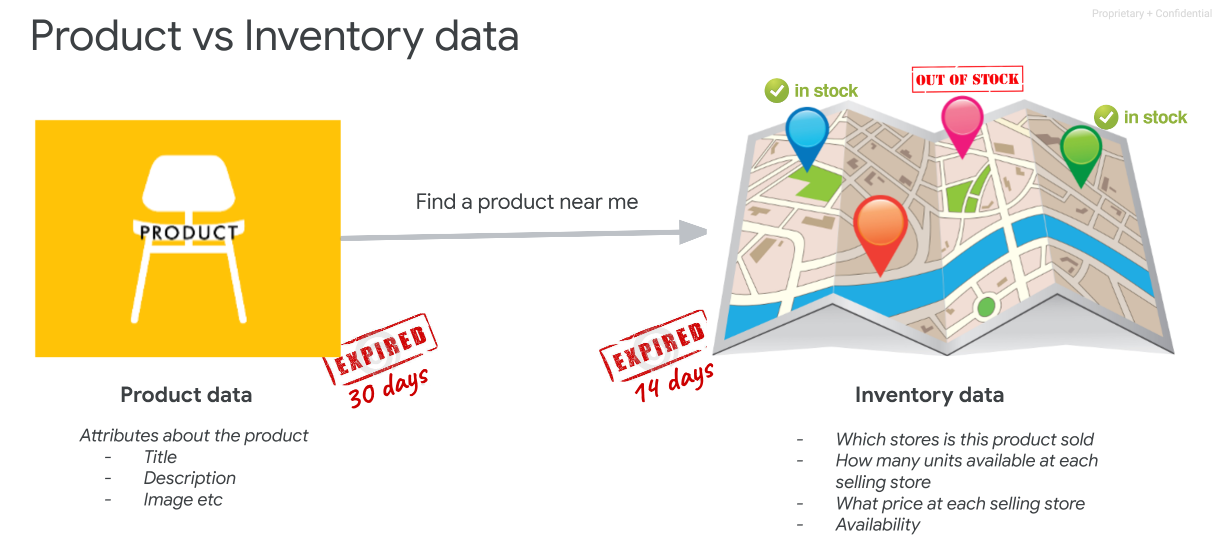API
身份验证
要通过指定的 Merchant Center 账号使用 Merchant API for Shopping,您需要 必须设置一个 API 控制台项目。Google Cloud 控制台项目帮助 您负责管理 Merchant API 解决方案的 API 访问权限和身份验证。
您可以通过以下两种方式访问 Merchant API,具体取决于用例:
- 建议使用 OAuth 2.0 来获取对特定 Merchant Center 的访问权限 通过您为用户开发的应用来登录您的账号。用户将 需要向您的账号授予访问权限,以便代表他们提交数据。
- 服务账号是一种特殊的账号,通常由 而不是一个人。服务账号由其电子邮件标识 该地址对账号来说是唯一的。
参阅如何使用 OAuth 2.0 或服务进行身份验证 账号。
启用国家/地区设置
调用 liasettings.update 来指定您在哪些国家/地区
投放本地广告
如需了解详情,请参阅“国家/地区设置”下的“定位条件”页面
发送优惠数据
数据有两种类型:商品数据和商品目录数据。

一次发送商品和商品目录数据
您可以使用 accounts.lfpInventories.insert
“GTIN”字段实际上将用作 Google 目录的商品标识码 系统会自动创建商品 Feed
自动创建的 Feed 在目标 Merchant Center 中将显示为 “本地 Feed 提供商”Feed 中包含与之相关联的相关商品的 Feed。
如果商家的所有商品都有 GTIN,而没有 功能(如商家自管的本地店面页面基本版)。 如果您打算为商家启用 MHLSF,请发送专门的商品 Feed 。
使用 accounts.lfpSales.insert 时,此流程同样适用
在这种情况下,数据是指特定商品在 。
分别发送商品和商品目录数据
如果 GTIN 不广泛提供,或者您更希望利用 目标 Merchant Center 账号中的现有产品 Feed,或者您想要 为您的商家启用 MHLSF,您需要有特定的本地商品 Feed。
这可以通过调用 accounts.productInputs.insert 启用
然后插入商品的所有静态值。务必将
将 Channel 属性设置为“local”。
如需详细了解基本商品数据,请参阅这篇文章以及 API 插入商品的一般指南。
数据流如下所示:
- 请先调用 accounts.productInputs.insert 以开始上传 商家的商品
- 然后调用 accounts.lfpInventories.insert 以提交商品目录 数据。
或者,您也可以通过 accounts.lfpSales.insert.然后,机器学习模型 根据这些数据预测商品的价格和数量。
accounts.lfpInventories.insert、accounts.lfpSales.insert 的概览示例 accounts.lfpStores.insert
发送商家资料数据
无法访问商家的 Google 商家资料账号的情况 检索商店代码,您可以通过 accounts.lfpStores.insert 替换为您自己的特定商店代码。
请注意,在调用 accounts.lfpinventoryories.insert 或 accounts.lfpSales.insert 商店代码需要与商店代码一致 lfp 商店请求中提供的地址。
accounts.lfpStores.insert 的响应还会提供 matchingState 和 matchingStateHint。
